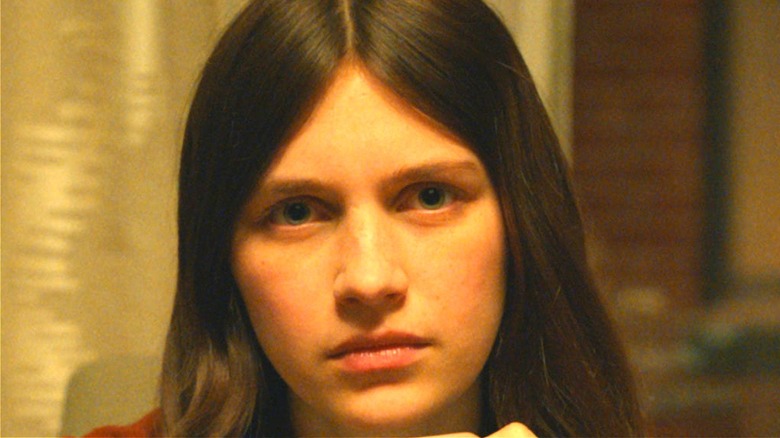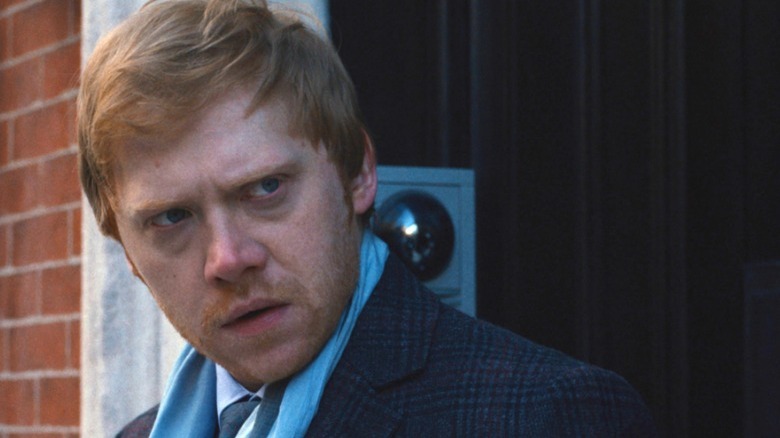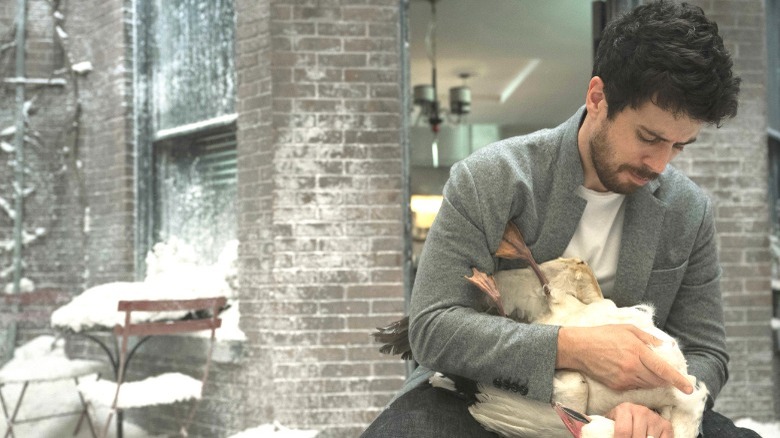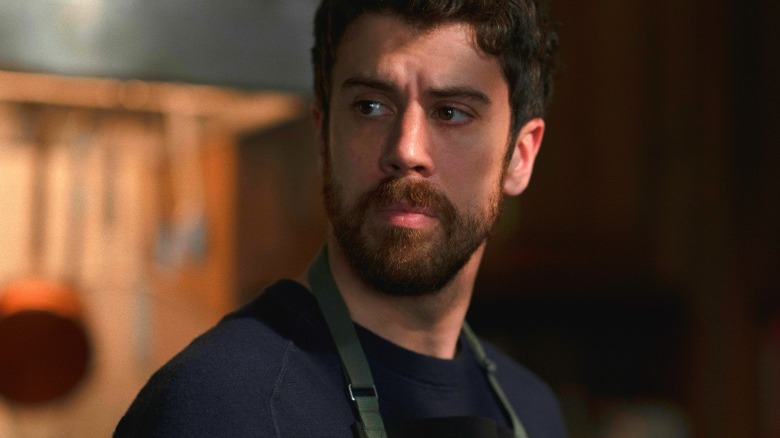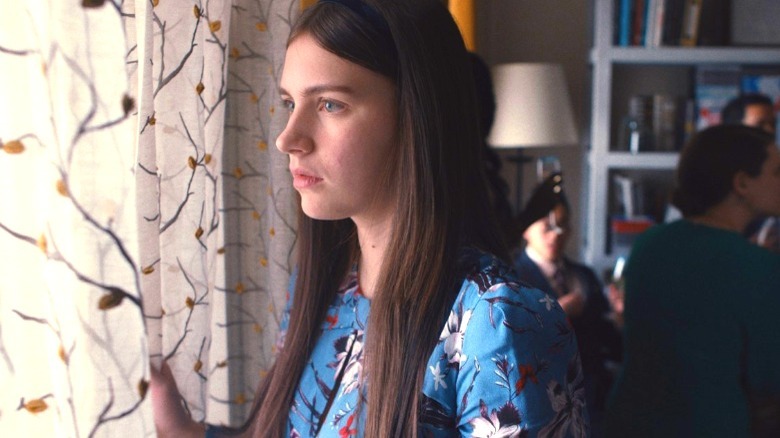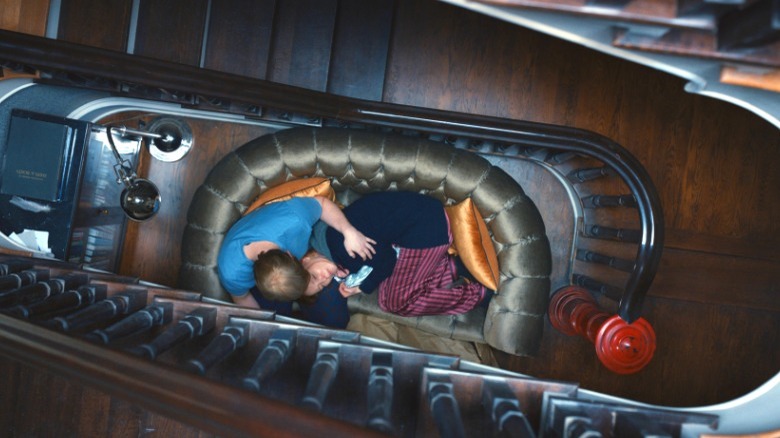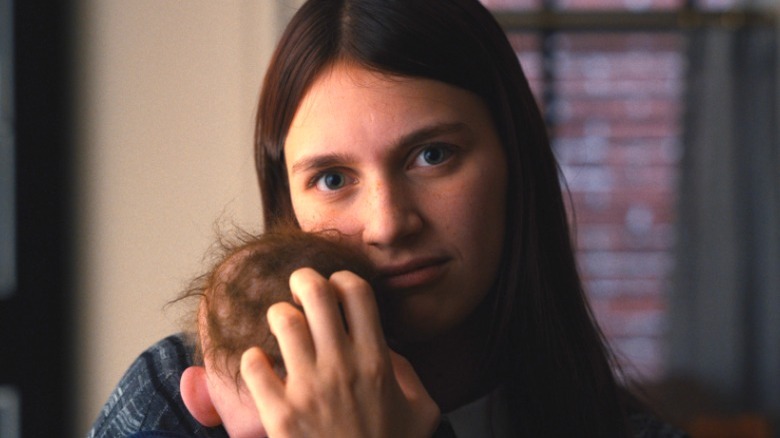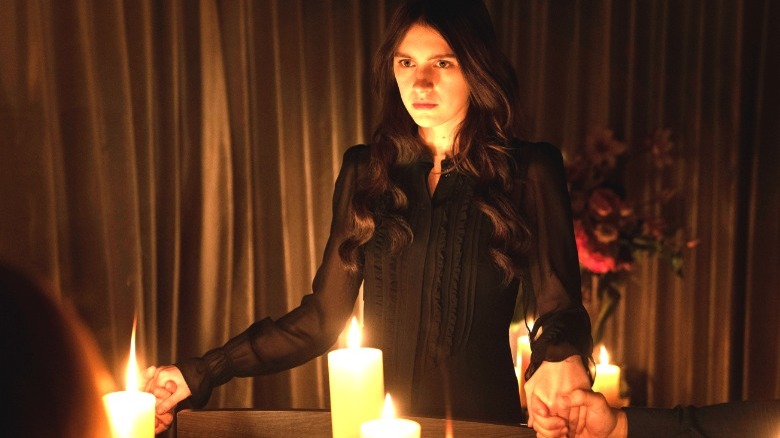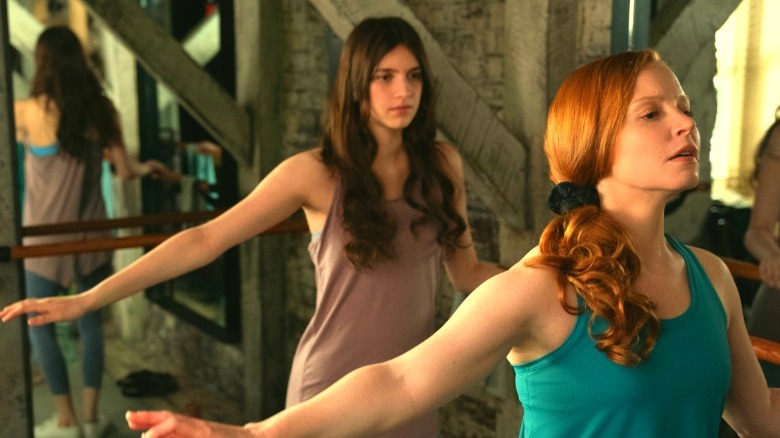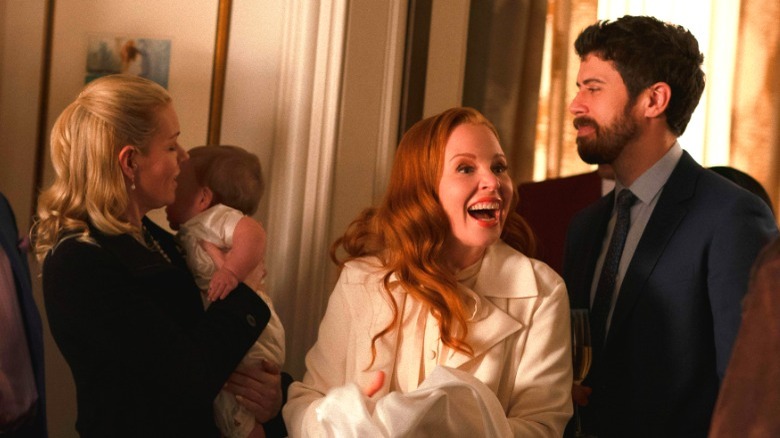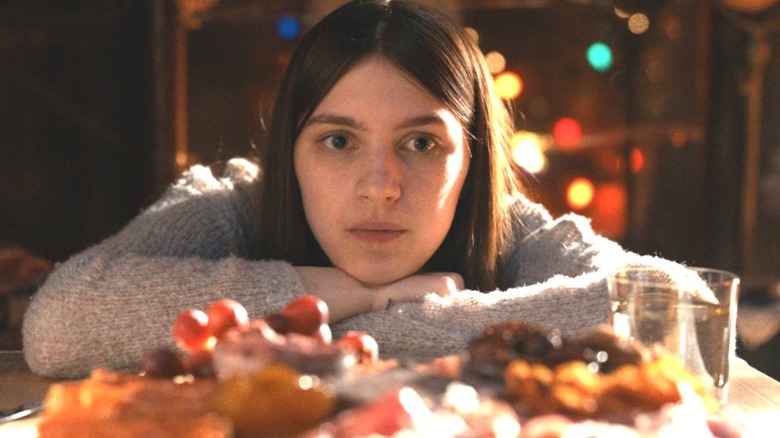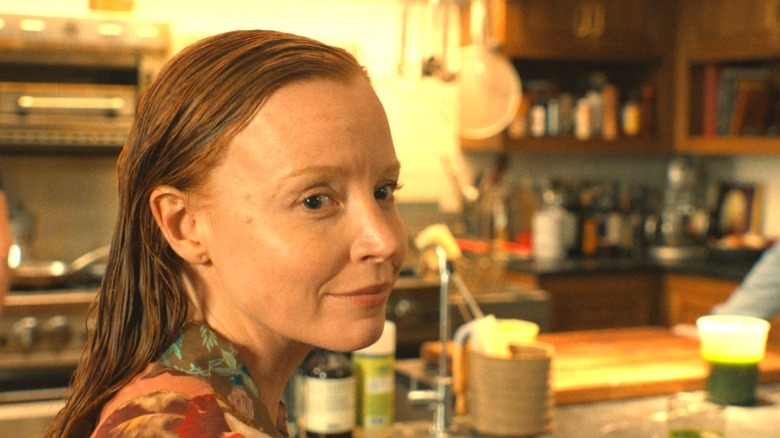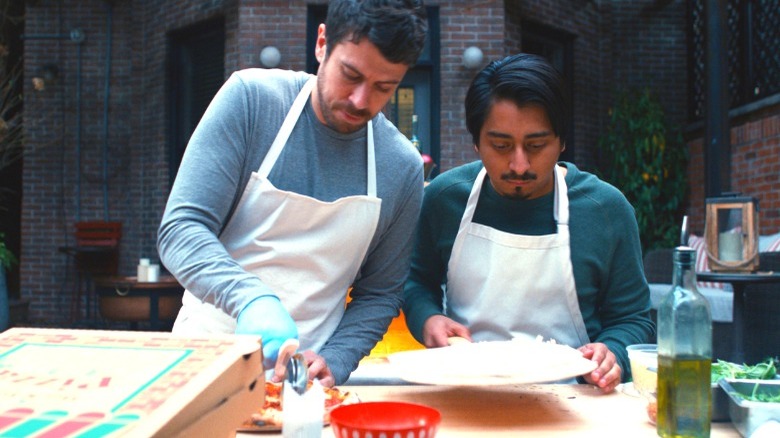Servant: Facts Only M. Night Shyamalan's Biggest Fans Know About The Apple TV Series
As Dorothy and Sean Turner of "Servant" learn, finding good childcare can be a tricky business. But things get even trickier when the person they invite into their home to care for their son Jericho turns out to be a cultist with some pretty screwy supernatural talents.
With its four fatally flawed central characters and "Lost" Dharma Initiative meets the "Twin Peaks" Black Lodge lore, "Servant" has earned a devoted fandom during its four-season run. Whether viewed as a meditation on grief, a morality tale about drowning loss in consumption, or a Luciferian parable, M. Night Shyamalan's "Servant" is one of the most beautifully rendered feats of storytelling in its genre. From candy-coated crickets to pain-inflicting dance-offs, the series is also full of surprises. If you love Jericho's family as much as we do, hit pause on your Betamax because we're looking into all the journal-worthy facts only Shyamalan's biggest fans know about "Servant" on Apple TV+.
The main cast is mostly British
Set in Philadelphia, Pennsylvania, "Servant" features central characters with some fairly distinct accents that stand out to the ear of anyone unfamiliar with the region. And according to Slate, it's one of the most difficult accents to perform even if Kate Winslet managed to perfect it in "Mare of Easttown" — which makes it that much more surprising that three of the main "Servant" cast are not even from the United States.
The titular servant Leanne is played by the London-born Nell Tiger Free, who some viewers may recognize from her role as Myrcella Baratheon on "Game of Thrones." Rupert Grint, who stars as Dorothy's ever-loyal and perpetually heartsick brother Julian, will be familiar to Potterheads from his work as Ron Weasley in the "Harry Potter" films. The Essex native was cast in the film series at only 11 years old. And Toby Kebbell, who appeared in the critically-acclaimed "Black Mirror" episode "The Entire History of You," hails from Nottinghamshire, according to the London Evening Standard. Speaking to the Providence Journal, Kebbell said he finds the American accent a significant undertaking, and that he continues to use it the entire time he is on set to stay on track. Among the main "Servant" cast, only Connecticut-born Lauren Ambrose is from the United States.
The food has a deeper meaning
The Turner's lives revolve heavily around the professions of parents Dorothy, a reporter, and Sean, a professional culinary expert with a scientific level of mastery when it comes to food and wine. Food plays a prominent role in the series both visually and symbolically with Sean preparing a unique culinary creation in every episode. But rather than look enticing, the emphasis on the process of food preparation often seems clinical, unsettling, or even gory as Sean prepares rabbits, eels, geese, lobsters, blowfish, and even crickets — a process that often begins with live animals.
Speaking on "Servant – The Food Featurette," M. Night Shyamalan emphasized the symbolic role food plays in the series as both "a metaphor for what's going on in each episode" as well as the characters' emotional states. Nowhere is this more apparent than Sean's ersatz cayenne recipe for Dorothy's breakfast when he tells Leanne, "She likes the idea of spicy food, but in reality, it doesn't agree with her" — an eerie parallel to Dorothy's inability to stomach other realities. The pure indulgence of Sean's high-end ingredients and adventurous recipes directly contrasts against the simple canned soup Leanne subsists on and the way Uncle George wipes his chicken down until it's simply a vehicle for nutrition. And in a series that delves into supernatural themes of fallen saints, some of the food preparation scenes bear a whiff of ritualistic animal sacrifice.
Sean is really cooking those meals
If Sean's food preparation process looks surprisingly realistic and detailed, that's because Toby Kebbell is actually cooking those meals himself. As the child of a professional Cordon Bleu chef, Kebbell grew up with an appreciation for the culinary arts. Speaking to a Variety panel, Kebbell explained that years of helping his mom in the kitchen honed his culinary skills. Part of his audition required demonstrating his knife skills, and Kebbell was so good the producers assumed he had worked professionally as a chef.
As highlighted in the featurette exploring the "Servant" food meaning, the show draws on the expertise of James Beard-winning Italian-trained chef Marc Vetri and Philadelphia chef Drew Ditomo, who are happy to walk Kebbell through each creation. The Turners' kitchen is a real working kitchen, and Shyamalan, who says he values the precision and detail master chefs bring to their craft, explained, "Toby, who plays Sean, loves to cook. He's all in."
Ultimately, the level of detail involved in the food preparation process and Kebbell's own relationship with cooking add to the realism of the show. According to Kebbell, Sean's meals are "life-giving" no matter how extravagant or even "overbearing" his command of the kitchen might seem. The fact that Kebbell could hack it in Gordon Ramsay's kitchen is the icing on the placenta cake.
They (almost) never leave the house
If it seems like the Turners spend a lot of time at home, it's because the show never leaves their house. In an A.V. Club interview, Shyamalan said, "I don't think anybody took me seriously when I said that we're never leaving the house for the entire show." According to the director, it was around the second season or so that the folks over at Apple started to get the picture.
Although the Turners and Julian do occasionally appear in other settings, every outside appearance in the early seasons is seen through an electronic device. "Servant" is an intimate tale about a family's life together and the grief they live with, even if they don't always — or in some cases ever — acknowledge it, so to keep the focus on the Turner home, Shyamalan would often take "the biggest, most cinematic things and then only shoot it on an iPhone."
As a reporter, Dorothy records every one of her news pieces, and Leanne frequently watches them on the small television in her bedroom. Characters occasionally appear in other settings through video calls like when Sean is on set for his reality show or the family phones Leanne from the beach. The show even includes a few glimpses of the Lesser Saints' cult life as depicted on a Betamax tape. With every season, the Turners expand into their attic, onto the street, and into the neighboring park. But you probably won't catch them visiting the Liberty Bell anytime soon.
The home is a character in its own right
Featured prominently throughout each episode and even in the show's introduction, the Turners' house is essential to the "Servant" story and in many ways seems to take on a life of its own – so much so that some fans have speculated it is much more than just a building. According to Philadelphia, the series was filmed in a Philadelphia rowhouse, with the owners offering its use in exchange for a donation to the pediatric brain tumor research department at the Children's Hospital of Philadelphia.
Built in the 1800s, the beautifully styled three-story Rittenhouse Square neighborhood townhouse features a grand gallery, a roomy gourmet kitchen, and a large basement and attic, giving the Turners a lot of room to stretch out in. Speaking about the house to Metro, Rupert Grint reflected, "It really did feel very strange in that house, and it was a real relief to leave. And especially rooms like the nursery were really weird." As the story progresses the house serves as a metaphor for the unattended cracks in the family's perfect veneer as the house itself begins to physically crack, crumble, and generally decay in some kind of supernatural reaction to Leanne's willfulness. From the termite-riddled staircase to the burst skylight in the attic to the yawning pit the Turners learn to live with in their basement, the house is a reminder that simply slapping a coat of grief over a problem means you'll only face bigger ones down the road.
The Reborn doll was originally too realistic
Like most M. Night Shyamalan projects, "Servant" features a significant twist. But in "Servant," viewers don't have to make it far into the first episode to get to it. The story begins with the Turners welcoming nanny Leanne to provide live-in care for their infant son Jericho. Although Dorothy and Leanne treat the child with attentive care, Sean appears to treat him with disdain and abuse when no one is looking until it's revealed that the child is actually a Reborn doll given to Dorothy shortly after the death of her real son. The empty eyes and uncanny appearance of the doll infuse the story with a sense of unease or even dread.
In 2008, ABC News reported on the hyperrealistic handcrafted dolls that have amassed their own subculture of fans in addition to their potential for use as therapy tools. But according to Shyamalan, the original doll was a little too lifelike. As Shyamalan relayed to The Hollywood Reporter when his mother saw the first ad for the series, she believed she was seeing a baby, and they ultimately realized the Reborn doll was indiscernible from an actual baby on camera. To solve the problem, the "Servant" production team had to give the doll a glow-down. As Shyamalan put it, "We had to make it look even more like a doll so you could tell what it was if you were driving by it."
M. Night drew on his Indian-American heritage for the storytelling
Like many filmmakers, M. Night Shyamalan takes his artistic influences from many sources. In the "Servant" featurette "Perspectives," the director cites George Lucas, Steven Spielberg, and Spike Lee as his early influences. As he dove deeper into filmmaking, Shyamalan became interested in directors like Akira Kurosawa, Alfred Hitchcock, and Stanley Kubrick, who inspired him to slow down the storytelling to create mystery and suspense. But one of the director's greatest influences is his lived experience as an Indian-born American, a heritage that features prominently in the decisions he made while directing "Servant."
Shyamalan emphasized that his heritage as the son of an immigrant is key to the unique perspective and storytelling style he brings to the table, explaining that his grandmother's worldview saw ghosts and the supernatural as a part of life. "That's the way I grew up, and that's where my culture is." As Shyamalan became familiar with foreign films, he also began to realize his pacing and other film elements that don't align with typical American films, instead telling stories that are "minimal and slower," something "rhythmically new" to many viewers. The portrait-like camera framing, dark humor, and focus on the Philadelphia setting are all part of what makes "Servant" unique.
It's meant to be a visual meditation
As Shyamalan explains in the "Perspectives" featurette, "Servant" is meant to serve as a "visual meditation," captivating viewers to put down their phones and focus solely on the story. Unlike stories told in a more generalized way, every frame in "Servant" is given great attention to detail. As Shyamalan emphasizes, "There's a reason that the shot's taking that long and there's no music, or you're just listening to breathing."
Examples of this can be seen throughout the series. As new visitors step into the Turner home, the camera focuses on their feet crossing the threshold, just as it follows the characters' feet as they slowly cross the floor of the old home, often adding to the sense of hesitation of where those feet are taking them. Dialogue between characters is often shot from odd angles, like the arms and hands of Julian and Sean as they share drinks and talk about their Leanne problem or the shoulders-down shots of dialogue between Sean and Dorothy.
One of the most notable examples of this visually stunning camera work is the dinner scene in "Haggis," which finds the Turners and their dinner guests' faces obscured by an intrusive purple balloon in the center of the table. The effect is artful and almost poetic as the camera focuses on fizzing drinks or a dandelion being gingerly placed atop a bowl of green soup, underlining the fact that the Turners can't see the unresolved issues right in front of them.
Episodes are filmed chronologically
Anyone who has watched a lot of bonus features will be familiar with the fact that most productions are filmed out of order with the pieces of the story arranged after filming to create the perfect end product the world comes to know and love. With limited budgets, schedule crunches, and limited access to certain locations, filming scenes and episodes out of order is often a necessary part of life. But "Servant" is a rare example of a series that films every episode in order, owing in large part to the fact that the show is filmed primarily in the Turner home.
The series is written by showrunner Tony Basgallop, who penned every episode of the show's first season and most of the subsequent episodes. Although the first nine episodes of the show had been written before filming began, Lauren Ambrose told Build the show was "shot like — cuckoo levels of chronologically," comparing the series to a play. Rupert Grint echoed the sentiment in an interview with Backstage, emphasizing the challenges of filming productions out of order and the level of surprise the show was able to maintain even for the actors. According to Grint, it's much easier for actors to track their characters' journeys, and much like the show's central family, "We have no idea what's around the corner."
The show has always been moving toward its ending
Before the Golden Age of Television, most television writers were effectively just winging it. Often stringing their audiences along from one week to the next, with no higher goal than keeping their ratings up and postponing their inevitable cancellation for as long as possible. But thanks to the advent of delayed viewing, writers have the luxury of being much more intentional with their storytelling, which means fewer of the dangling mysteries and loose ends of otherwise beloved shows like "Lost" and "The X-Files."
According to The Hollywood Reporter, Shyamalan and Basgallop had the ending of "Servant" planned out early in the series, and even if the actors weren't in on the show's secrets, the directors and writers were. Explained Shyamalan, understanding where the show was headed gave the production team the ability to focus on details that moved in the right direction, offering "the opportunity to make mistakes and redo it again. It was not only safe to do that, but it was encouraged." In an interview with Digital Spy, Shyamalan said he originally envisioned the show clocking in at 60 episodes over a total of six seasons. But as the story developed and he fine-tuned the story arc, he realized four seasons was a better number, saying, "I don't want to feel that 'he limped across the finish line while he was actually trying to do something else' – that would be sad."
They intentionally use weird directors
As a director known for his markedly different approach to filming, Shyamalan understands the value of bringing a unique perspective to the director's chair. In the "Perspectives" featurette, Shyamalan emphasized his appreciation for the experience of working with and learning from as many people as possible. According to the director, he enjoys taking risks with everyone on set — writers, directors, editors, costume designers, composers, production designers, and actors alike. "It's like film school," he reflected. "I'm taking full advantage of it, and it's affecting my movies."
As someone who enjoys supporting other filmmakers and "teaching them to follow their voice," Shyamalan says he often chooses "weird and different" directors because he enjoyed a short film they produced or saw their work at a film festival. And often, these voices are from many different corners of the world. The show's directors include talents like Lisa Brühlmann ("Killing Eve"), Alexis Ostrander ("Sweet Tooth"), Daniel Sackheim ("Ozark"), and Palme d'Or winners like Julia Ducournau ("Titane").
According to Shyamalan, encouraging other filmmakers and helping them find their own unique voice as a filmmaker is one of the key reasons "Servant" stands apart as a distinctive story in a world full of typical dramas. The fact that everyone is working toward a common goal with a different sensibilities to Shyamalan is crucial to the show's success.
The cast and crew ate the Cheesus Crust pizza
As a genre-defying supernatural psychological horror, "Servant" can often be moody, atmospheric, and brooding. But this bleakly surreal ambience is the perfect backdrop for the show's many darkly comedic moments, and one of the best is the Turners' temporary foray into the world of pizza delivery. One of the Turner family's defining traits is their tendency to be over-the-top: whether it's Sean's lobster ice cream or Dorothy's always-on reporter persona. That's why it's the most Turner thing ever when they create an entire pizza delivery service down to the printed menus and pizza boxes in order to spy on their absent childcare worker and track down their missing son, Jericho – even if everyone but Dorothy thinks he isn't their son at all ("Pizza").
Believing Leanne to be holed up with her cult buddies and having totally missed the part about how they only eat plain food, the Turners create a religious-themed takeout business called "Cheezus Crust." The bid works, and 20 cheese pizzas later, they've found Leanne. Because all of the food on the show is real, this meant the "Servant" cast and crew got their own pizza party. In M. Night Shyamalan's Reddit AMA for "Servant," the director explained that after finishing each take, the pizza would go to the crew, and one day the producers even showed up. As for Night's favorite pizza? He prefers a little sausage with chili oil drizzled on top.
